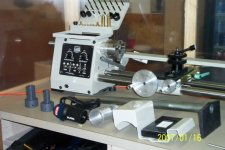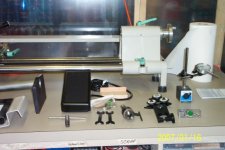Kenny said:
While the price of a 12x36 metal lathe seems to be half the price of any of the cue building lathes, there are a few differences.
The metal lathe
10 times the space
not portable
comes with a couple of chucks, usually very low end and not accurate
comes with nothing else that you will need to build or work on cues
cost of tooling is usually more than the lathe
resale is low
hard to move
replacement parts are expensive
bigger lathes get you hurt much quicker if you have not used a lathe before
cue makers lathe
ready to work out of the package
cost more on paper but value is in all tooling plus that is included
portable
easy to sell for close to price paid
replacement parts relatively inexpensive
you have customer service after the sale
I have 5 vintage american iron metal lathes
I think you have a couple of good points here and a couple of misconceptions also. A larger heavier metal lathe does take up more room, certainly not 10 times more room unless your cue makers lathe is sitting on a shelf boxed in where you just stick your hands in to use it. True, a large metal lathe is not portable. Yes they usually come with a couple of cheaper chucks that are not as accurate as they could be but then again, they are still more accurate than what comes on a cue maker lathe.
I would also be interested to know just what tooling is needed for a larger lathe that is not also needed for a cue makers lathe? There are, of coarse, much tooling that COULD be purchased for a machine lathe to make it operate more quickly and efficiently that can't even be used on the cue makers lathe but then they aren't necessary.
As far as resale, why would you think that a larger lathe such as a 13X36 or 40 not be easy to sell? Very large heavy lathes such as Sebastions and LeBlonds an such don't sell for what they should because machine shops have all gone to CNC and they are just to large and heavy for most homeowners with small shops. Your lighter, imported lathes hold their value very well as they are fairly easy to move and still plenty big enough for most hobbyist or home shop work. I have an Enco I bought 15 years ago new and I could sell it today for almost what I paid for it. Depending on what type lathe you have, some parts may be more expensive or harder to get but then again, with a full size lathe and a small mill/drill, there are few parts or accessories you can't make yourself or easily adapt from something else. With-in two days after the arrival of my Enco lathe in 1991, I had made and installed a full length taper attachment for the cost of less than 15.00, an adapter and an old chuck installed on the rear of the spindle with less than 5.00 invested and about 25 different size colletts so as not to mark the cue for well under 10.00.
As far as I'm concerned, the only true benefits of a cue makers lathe over bigger lathes are : portability and less room needed how ever with all the other equipment that is needed for building cues ( saws, spray booth, wood storage and such) I don't really see this as a problem, easier to get started out of the box and the maker of the lathe to fall back on for guidance in cue making.
Bigger lathes have to many benefits to even list.
Dick
By the way, I have 11 lathes but who's counting


